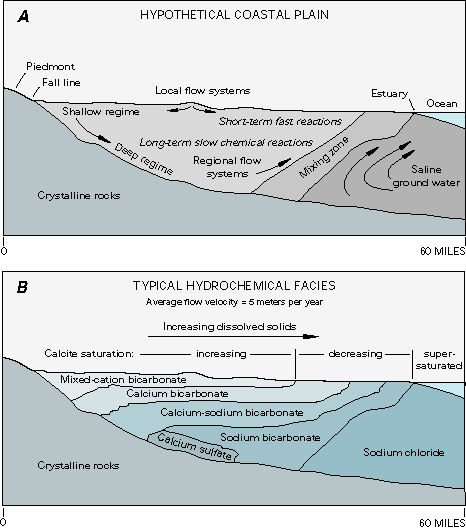E
Evolution of Ground-Water Chemistry from Recharge to Discharge Areas in the Atlantic Coastal Plain
Changes in the chemical composition of ground water in sediments of the Atlantic Coastal Plain (Figure E-1) provide an example of the chemical evolution of ground water in a regional flow system. In the shallow regime, infiltrating water comes in contact with gases in the unsaturated zone and shallow ground water. As a result of this contact, localized, short-term, fast reactions take place that dissolve minerals and degrade organic material. In the deep regime, long-term, slower chemical reactions, such as precipitation and dissolution of minerals and ion-exchange, add or remove solutes. These natural processes and reactions commonly produce a predictable sequence of hydrochemical facies. In the Atlantic Coastal Plain, ground water evolves from water containing abundant bicarbonate ions and small concentrations of dissolved solids near the point of recharge to water containing abundant chloride ions and large concentrations of dissolved solids where it discharges into streams, estuaries, and the Atlantic Ocean.

|
Figure E-1: In a coastal plain, such as along the Atlantic Coast of the United States, the interrelations of different rock types, shallow and deep ground-water flow systems (regimes), and mixing with saline water (A) results in the evolution of a number of different ground-water chemical types (B). (Modified from Back, William, Baedecker, M.J., and Wood, W.W., 1993, Scales in chemical hydrogeology--A historical perspective, in Alley, W.M., ed., Regional Ground-Water Quality: New York, van Nostrand Reinhold, p. 111-129.) (Reprinted by permission of John Wiley &
Sons, Inc.)